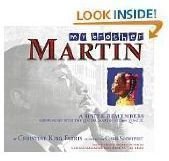How to Teach Preschoolers About Martin Luther King Jr.: A Lesson Plan
The Earliest Diversity Lesson
Martin Luther King Jr. was an inspiration to many people. He made great strides to provide African Americans with the rights and
freedoms that Caucasians had. His accomplishments are important events in history that everyone should learn about in our country. However, these concepts of discrimination and equality are difficult for young children to understand. This lesson shows you how to present the story and encourages the students to think about their dream for our world.
There are several books for young learners, including the one pictured to the right by Marion Dane Bauer and Jamie Smith.
Materials
-
My Brother, Martin: A Sister Remembers Growing Up with the Rev.Dr. Martin Luther King Jr. by Christine King Farris

-
March On! The Day My Brother Martin Changed the World by Christine King Farris
-
Large chart paper
-
Marker for chart paper
-
Blank paper
-
Crayons
Directions
Tell the students that you are going to learn about a very important man whose birthday is coming up soon and is always celebrated on the third Monday in January. Ask the students if they know who it may be. Tell them that his name is Martin Luther King Jr., and he is a large reason that our lives are the way they are now.
Begin by reading My Brother, Martin: A Sister Remembers Growing Up with the Rev. Dr. Martin Luther King Jr. by Christine King Farris, who is Martin’s sister. As you read the story, make sure that you go slowly and pause regularly to summarize what the book is saying. When you are finished reading, discuss the things Martin did as a child. Ask the students how many of these things they do as a child also. Explain that Martin Luther King Jr. was just a normal kid who did normal things and he grew up to do great, important accomplishments in life. Explain that your students all also have the potential to do great things and make a difference in the world.
Give each student a piece of paper and crayons and ask them to draw a self-portrait. Allow the children to share their drawing with the class. Once all of the drawings are collected, you can use them to create a bulletin board titled “I’m Important, Too: A Tribute to Martin Luther King Jr.” Discuss with the students that even though we are different in many ways (skin color, hair color, eye color, height, weight, personality, family, age, etc.) we are all important. We are all the same because we are all people who want to be treated nicely, need love, eat food, drink water, and more. You may want the students to brainstorm other ways all people are alike.
Once you are done discussing his childhood, tell the students that Martin did things as an adult to end discrimination. Ask the students if anyone knows what discrimination is. (Chances are they will not.) Explain that discrimination is treating someone differently because they are not like you. Explain that Martin was trying to end discrimination based on the color of someone’s skin, but it is also discrimination if you treat someone differently because of his or her sex, religion, intelligence, physical challenges, or ability.
Show the students concrete examples by acting out situations. Ask the students to tell you if each situation is discrimination or not. Some possible examples include:
- “You can’t play with us. We don’t like boys!”
- “You can’t play with us because the teacher said only 3 people could be on the slide, and there are already 3 of us playing here.”
- “My mom says I can’t play with you because you don’t go to church.”
- “My mom says I can’t play with you until I finish my homework.”
Next, read March On! The Day My Brother Martin Changed the World by Christine King Farris. This book focuses more on Martin’s accomplishments as an adult. Now that the students understand discrimination, have the students list the actions Martin took to try to end discrimination. Encourage the students to list things Martin did in the two books you read.
Once the list is complete, tell the students about the “I Have a Dream” speech. Explain that this speech was Martin’s dream of what the world would be like in the future after his work to end discrimination. Tell the students that Martin made our country a better place where everyone was treated equally. Next, give students a piece of construction paper (different colors, if you choose) and have them trace their hand on it twice. They will then cut them out. Have a large Earth made out of butcher paper on a bulletin board or wall section. The students will come put their hands up around the Earth to show how we all work together and are part of one united nation.
Extending
Discrimination and changing the world can be very difficult to explain to young children. This lesson can help make some of these concepts easier to comprehend. For more ideas on teaching equality and about Martin Luther King Jr., check out a Citizenship Lesson Plan on Martin Luther King Jr.
